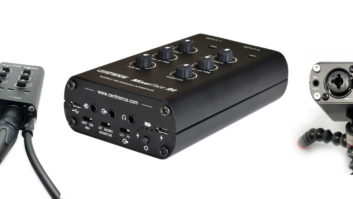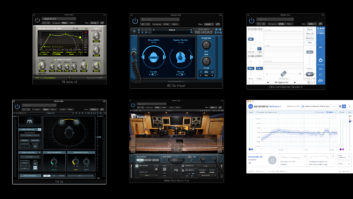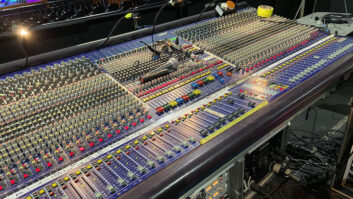Recently, two innovative noise-reduction plug-ins, Audionamix IDC (Instant Dialogue Cleaner) and McDSP NR800, have hit the market. Though quite different in design and application, both are noteworthy.
Audionamix has made a reputation for itself by creating software like Trax Pro, which can separate such elements as vocals or melody instruments from within a mixed track. IDC ($199, Mac/Win) uses artificial intelligence to isolate the speech part of a recording from the background noise, then allows you to control the level of each. Unlike many noise reducers, which can be tricky to use and require a fair bit of trial and error, IDC provides an impressive combination of simplicity and power.
The GUI features only four controls. The most important is the large knob in the center labeled Background, which is a level control for the background noise. As you listen to the track, you simply turn the knob down and the noise goes away. By giving the noise its own control, IDC lets you dial in as much or little of the reduction as you need.
Read more Mix Blog Studio: Residual Knowledge
The Strength slider allows you to increase the reduction process for really noisy recordings, and the Speech slider lets you increase only that part of the audio. You also get an RMS meter and Output slider for monitoring and controlling levels, respectively.
I tried IDC on a variety of noisy dialog recordings, including ones with fans or AC units in the background, and even a recording of an interview featuring fairly loud ocean sounds. The plug-in effortlessly handled all but the most upside-down (noise louder than source) examples I tested. For just about all the material I tried it on, I merely had to turn down the Background knob and the results were clear and artifact-free.
If you want robust and super-easy-to-use noise reduction for post-production on video soundtracks, podcasts, and other spoken-word recording applications, IDC is amazingly powerful.
If you don’t mind a more hands-on experience and want noise reduction that you can use not only on dialog, but on music tracks, too, you’ll want to check out the McDSP NR800 ($99 native, $149 HD, Mac/Win/VENUE S6L). It’s a groundbreaking product because its processing doesn’t add artifacts.
Most noise reduction software uses a process that includes a transform algorithm, usually some variation of a Fast Fourier Transform, to separate its frequency contents, find the noise and reduce it. While it’s definitely effective, this method can add artifacts that degrade sound quality, giving the audio that “underwater” sound at high settings.
McDSP founder and CEO Colin McDowell explained how the NR800’s approach is different. He said the plug-in utilizes “active processing that continually tracks signal levels at a variety of frequencies, using a network of EQs, filters and detectors that operate in the same domain as the audio, so no transform is required.”
The NR800 sports a 3D GUI that looks like a console and features eight independent bands of reduction (split by frequency range), as well as highpass and lowpass filters that are before the noise reduction in the signal chain.
I tested the NR800 on a variety of sources and found it to be extremely capable. What’s more, on everything but ridiculously extreme settings, its processing didn’t impact audio quality. That makes it extremely potent for cleaning up noisy music tracks as well as dialog. It can even be used for reducing bleed on drum tracks.
The only tradeoff for all this power is that the NR800 requires some work on the user’s part to dial out the noise. Finding the right setting often takes a bit of experimentation, and with so many adjustable parameters, it can be a bit daunting at first.
McDSP does include a bunch of presets that are good starting points and a variety of different Bias algorithms that also help you find the most effective setting. The NR800 offers a unique and powerful approach to noise reduction that gives you an unprecedented amount of control over the process—and no artifacts.







